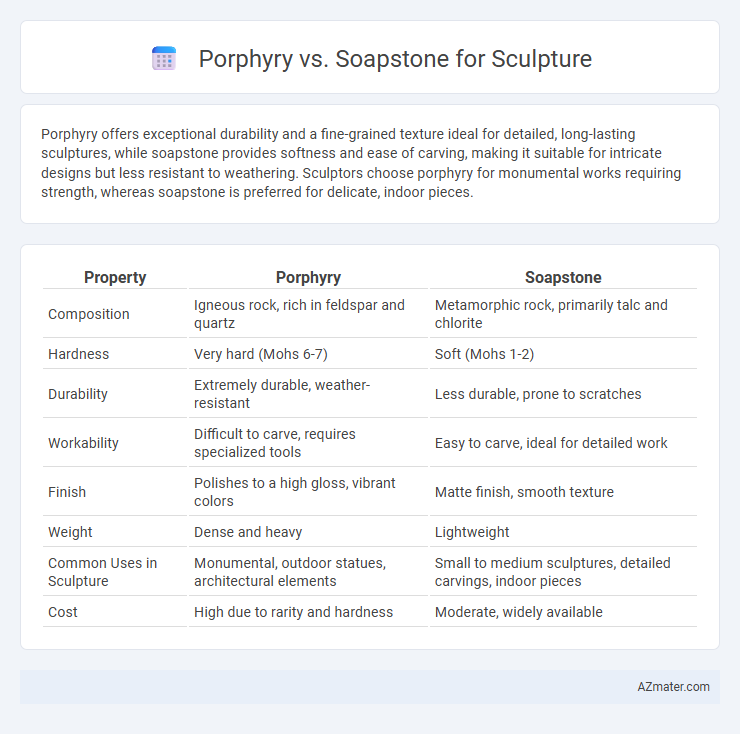Porphyry offers exceptional durability and a fine-grained texture ideal for detailed, long-lasting sculptures, while soapstone provides softness and ease of carving, making it suitable for intricate designs but less resistant to weathering. Sculptors choose porphyry for monumental works requiring strength, whereas soapstone is preferred for delicate, indoor pieces.
Table of Comparison
| Property | Porphyry | Soapstone |
|---|---|---|
| Composition | Igneous rock, rich in feldspar and quartz | Metamorphic rock, primarily talc and chlorite |
| Hardness | Very hard (Mohs 6-7) | Soft (Mohs 1-2) |
| Durability | Extremely durable, weather-resistant | Less durable, prone to scratches |
| Workability | Difficult to carve, requires specialized tools | Easy to carve, ideal for detailed work |
| Finish | Polishes to a high gloss, vibrant colors | Matte finish, smooth texture |
| Weight | Dense and heavy | Lightweight |
| Common Uses in Sculpture | Monumental, outdoor statues, architectural elements | Small to medium sculptures, detailed carvings, indoor pieces |
| Cost | High due to rarity and hardness | Moderate, widely available |
Introduction to Porphyry and Soapstone
Porphyry is a durable, coarse-grained igneous rock known for its deep purple or reddish color with large feldspar crystals, prized in sculpture for its striking appearance and hardness. Soapstone, a soft metamorphic rock primarily composed of talc, offers ease of carving and a smooth, soapy texture ideal for detailed and intricate sculptures. Both materials have been valued throughout history, with Porphyry excelling in monumental works and Soapstone preferred for fine, decorative carvings.
Geological Origins and Composition
Porphyry is an igneous rock characterized by large, well-formed crystals of feldspar embedded in a fine-grained matrix, originating from slow cooling magma deep within the Earth's crust. Soapstone, a metamorphic rock composed primarily of talc, forms through the alteration of ultramafic rocks under low-grade metamorphic conditions, resulting in a soft, soapy texture ideal for carving. The contrasting geological origins and mineral compositions of porphyry and soapstone dictate their hardness and workability, making porphyry highly durable and soapstone exceptionally malleable for sculpture.
Appearance and Color Variations
Porphyry exhibits a striking appearance with its deep red or purple base speckled by contrasting white or pink feldspar crystals, offering a vibrant and luxurious aesthetic often favored for bold sculptures. Soapstone, on the other hand, presents a softer, more muted palette ranging from pale gray, green, and brown to creamy white, providing a smooth and subtle visual effect that complements detailed carving. The color variations of porphyry are more dramatic and polished, while soapstone's natural matte finish highlights the material's tactile qualities.
Workability and Carving Techniques
Porphyry, known for its hardness and fine-grained texture, requires advanced carving techniques such as pneumatic tools and diamond-tipped chisels to achieve detailed sculptures, making it less workable for intricate designs. Soapstone is significantly softer and more malleable, allowing artists to use hand tools like rasps and knives for smooth, detailed carving and easier textural effects. Sculptors often prefer soapstone for its ease of manipulation and speed in shaping, while porphyry's durability makes it suitable for monumental works demanding long-lasting precision.
Durability and Longevity
Porphyry offers exceptional durability and longevity due to its hard, igneous nature, making it highly resistant to weathering and erosion over time. Soapstone, while easier to carve, is much softer and more prone to scratches and wear, resulting in a shorter lifespan for sculptures exposed to outdoor elements. Sculptors seeking enduring works often prefer porphyry for its robust resistance and ability to maintain fine details for centuries.
Historical Uses in Sculpture
Porphyry, prized in ancient Rome and Egypt, was historically used for imperial statues and architectural elements due to its durability and rich purple color symbolizing power. Soapstone, softer and easier to carve, has been a preferred medium for indigenous and folk sculptors worldwide, particularly in Native American and Inuit art traditions. The contrast in hardness and appearance led to distinct uses: porphyry for monumental, enduring works and soapstone for intricate, portable carvings.
Suitability for Fine Detail
Porphyry's hardness and coarse grain make it challenging for intricate detailing, resulting in a more rugged texture compared to soapstone. Soapstone's softness and fine grain allow artists to carve delicate, precise features easily, making it highly suitable for detailed sculptures. While porphyry offers durability and a unique appearance, soapstone remains the preferred choice for fine detail work in sculpting.
Maintenance and Preservation
Porphyry sculptures require minimal maintenance due to their hardness and resistance to weathering, retaining detail even in outdoor environments, while soapstone demands more careful preservation as it is softer and more prone to scratching and erosion. Regular cleaning with mild soap and water helps protect soapstone, and periodic oiling can enhance its appearance and prevent drying or cracking. Porphyry's durability makes it ideal for long-term outdoor installations, whereas soapstone is better suited for indoor or sheltered displays where it can be maintained more delicately.
Cost and Availability
Porphyry is a highly durable and dense igneous rock, often more expensive and less readily available due to its rarity and historical significance in sculpture. Soapstone, a softer metamorphic rock, offers greater affordability and widespread availability, making it a popular choice for beginner sculptors and artisans. Cost differences largely stem from porphyry's hardness requiring specialized tools and longer carving times, whereas soapstone's softness reduces labor and tooling expenses.
Choosing Between Porphyry and Soapstone for Your Sculpture
Porphyry offers exceptional hardness and durability, making it ideal for outdoor sculptures that require weather resistance and long-lasting detail retention. Soapstone, known for its softness and ease of carving, allows sculptors to achieve intricate designs more quickly, especially suited for novices or projects needing fine detail. Choosing between porphyry and soapstone depends on the desired balance of durability, carving complexity, and the sculpture's final environment.

Infographic: Porphyry vs Soapstone for Sculpture
 azmater.com
azmater.com